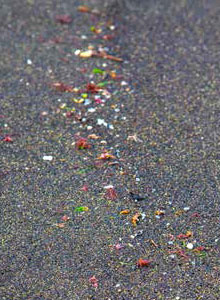Biodegradable plastic, not a panacea to marine litter problem-UN report

Environmental awareness has spurred demand for biodegradable materials – plastics included. Nonetheless, adoption of biodegradable materials in products is found to neither significantly reduce the bulk of waste plastics entering the oceans nor mitigate the physical and chemical risks that plastics pose to marine environment, according to a new report by the United Nations Environment Programme (UNEP), entitled Biodegradable Plastics and Marine Litter: Misconceptions, Concerns and Impacts on Marine Environments.
The study aims to present concise summary of some of the key issues surrounding the biodegradability of plastics in the oceans, and whether the adoption of biodegradable plastics will reduce the impact of marine plastics overall, says UNEP.
While there is no quick fix to reducing negative environmental impacts, biodegradable plastic is often regarded as a be-all solution to marine litter problem,
But this “solution” is still a topic for debate. For one, there is still lack of precise definition of what is biodegradable and the degree of biodegradability of plastics.
“The degree to which biodegradable plastics actually biodegrade in the natural environment is subject to intense debate, “according to the report.
Moreover, much of the commonly used plastics such as polyethylene (PE), polypropylene (PP) and polyvinyl chloride (PVC) are not biodegradable in marine environments, the report says.
In the case of polymers, while they biodegrade under favourable conditions, they breakdown much slower in the ocean.
“The conditions under which ‘biodegradable ́ polymers will actually biodegrade vary widely. For example, a single-use plastic shopping bag marked biodegradable may require the conditions that commonly occur only in an industrial composter (e.g.,50 °C) to breakdown completely into its constituent components of water, carbon dioxide, methane, on a reasonable or practical timescale, “ the report stated.
This reason, augmented by the fact that polymers have wide-spread adoption, thereby increases the potential of polymers to contribute to marine litter.
Oxo-degradables under scrutiny
The UNEP report also looked into how oxo-degradable plastics that contain pro oxidant, such as manganese, which precipitates their fragmentation, can contribute to rising marine litter. In marine environments, the fragmentation can take up to 5 years, during which the plastic objects continue to litter the ocean, says UNEP, adding that even after fragmentation, oxo-biodegradables are still potential contaminants to marine ecosystems.
“It should be assumed that microplastics created in the fragmentation process remain in the ocean, where they can be ingested by marine organisms and facilitate the transport of harmful microbes, pathogens and algal species,” the report also cited.
Labels can be misleading
The so-called “technological solutions” to solving marine litter, for example, often serve as alternative to changing behaviour. More specifically, labelling a product as biodegradable is more a “technical fix” than a solution that would enforce accountability to taking action in proper waste management.
Having said this, biodegradable plastics are no different from traditional plastics in their potential to sabotage marine environment. “Labelling claims (regarding green credentials of materials or products) could even confuse the public, “ UNEP says.
UNEP therefore advices that users must have “access to reliable, authoritative and clear guidance on what terms such as ‘degradable’ or ‘biodegradable actually mean and what caveats may apply, “ if they are to make informed decisions.
Fishing out for better solution
In a press release, UNEP’s Executive Director Achim Steiner said that an estimated 20 million tonnes of plastic ending up in the world’s ocean yearly and these plastics break down into microplastics. He therefore recommends for “more responsible approach to managing the lifecycle of plastics” to unburden the oceans and ecosystems.
The report also cited the key reasons for plastics being a main culprit in marine litter flakincluded inadequate waste management by the public and private sector; illegal practices; littering by individuals and groups; accidental input from land-based activities and the maritime sector, including geological and meteorological events; a lack of awareness on the part of consumers ( such as for using products that contain microplastics ).
While these two major pitfalls have been identified, the bottom line of how plastics end up in the oceans is poor waste management as well as under appreciation for plastics, the UNEP report says: “Plastics are ubiquitous in the oceans as a result of several decades of poor waste management, influenced by a failure to appreciate the potential value of ‘unwanted’ plastic.”
(PRA)Copyright (c) 2015 www.plasticsandrubberasia.com. All rights reserved.









































